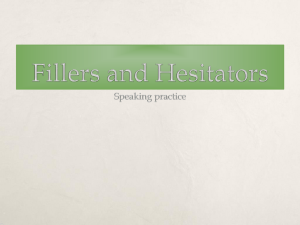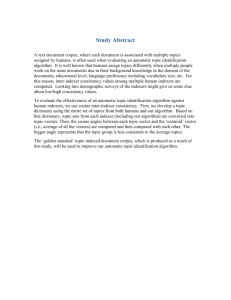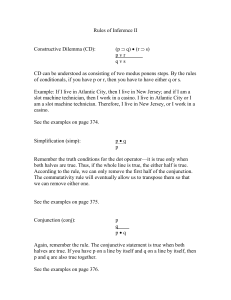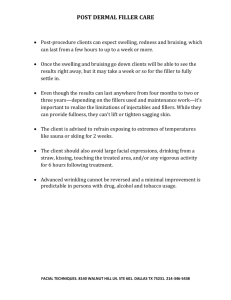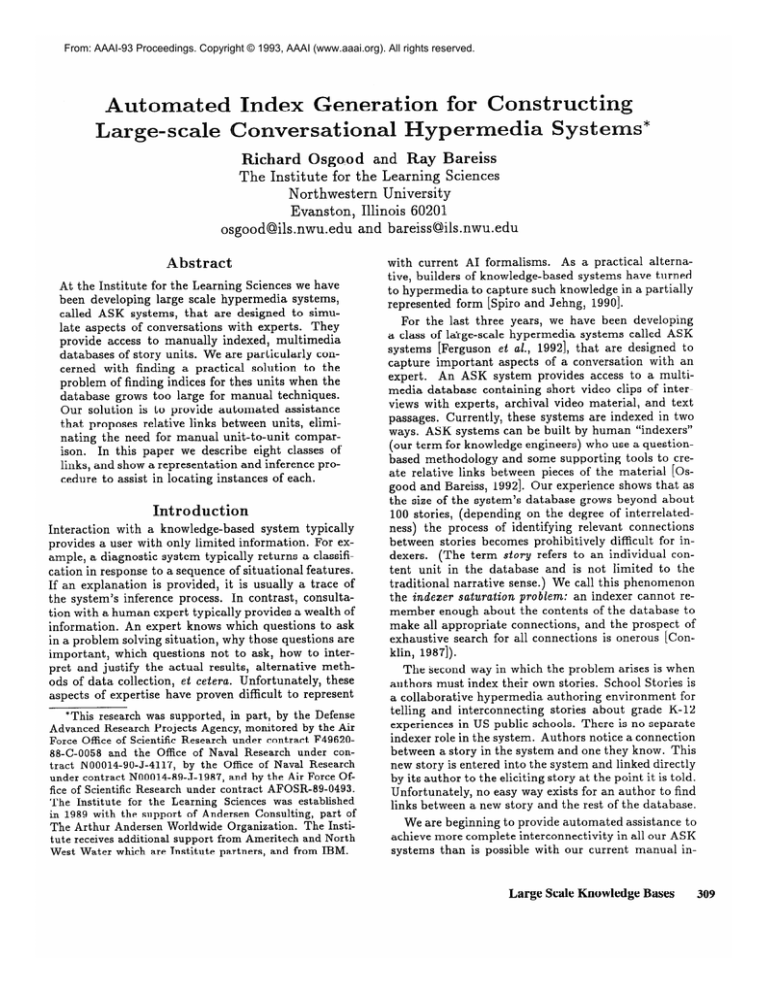
From: AAAI-93 Proceedings. Copyright © 1993, AAAI (www.aaai.org). All rights reserved.
Automated
arge-scale
Index Generation
vers
Richard
The
Qsgo.od
Institute
and
Ray
for the Learning
Northwestern
Evanston,
osgood@ils.nwu.edu
Abstract
At the Institute for the Learning Sciences we have
been developing large scale hypermedia
systems,
called ASK systems, that are designed to simulate aspects of conversations
with experts.
They
provide access to manually indexed, multimedia
databases of story units. We are particularly
concerned with finding a practical
solution to the
problem of finding indices for thes units when the
database grows too large for manual techniques.
Our solution is to provide automated
assistance
that proposes relative links between units, eliminating the need for manual unit-to-unit
comparison. In this paper we describe eight classes of
links, and show a representation
and inference procedure to assist in locating instances of each.
Introduction
Interaction
with a knowledge-based
system typically
provides a user with only limited information.
For example, a diagnostic system typically returns a classification in response to a sequence of situational features.
If an explanation
is provided, it is usually a trace of
the system’s inference process.
In contrast, consultation with a human expert typically provides a wealth of
information.
An expert knows which questions to ask
in a problem solving situation, why those questions are
important,
which questions not to ask, how to interpret and justify the actual results, alternative
methods of data collection,
et cetera. Unfortunately,
these
aspects of expertise have proven difficult to represent
*This research was supported, in part, by the Defense
Advanced Research Projects Agency, monitored by the Air
Force Office of Scientific Research under contract F4962088-C-0058
and the Office of Naval Research under contract N00014-90-J-4117,
by the Office of Naval Research
under contract N00014-89-J-1987,
and by the Air Force Office of Scientific Research under contract AFOSR-89-0493.
The Institute for the Learning Sciences was established
in 1989 with the support of Andersen Consulting, part of
The Arthur Andersen Worldwide Organization. The Institute receives additional support from Ameritech and North
West Water which are Institute partners, and from IBM.
for Constructing
er
Bareiss
Sciences
University
Illinois
60201
and bareiss@ils.nwu.edu
with current AI formalisms.
As a practical alternative, builders of knowledge-based
systems have turned
to hypermedia to capture such knowledge in a partially
represented form [Spiro and Jehng, 19901.
For the last three years, we have been developing
a class of large-scale hypermedia systems called ASK
systems [Ferguson et al., 19921, that are designed to
capture important
aspects of a conversation
with an
expert.
An ASK system provides access to a multimedia database containing short video clips of interviews with experts, archival video material, and text
passages. Currently, these systems are indexed in two
ways. ASK systems can be built by human “indexers”
(our term for knowledge engineers) who use a questionbased methodology
and some supporting tools to create relative links between pieces of the material [Osgood and Bareiss, 19921. 0 ur experience shows that as
the size of the system’s database grows beyond about
100 stories, (depending on the degree of interrelatedness) the process of identifying
relevant connections
between stories becomes prohibitively
difficult for indexers.
(The term story refers to an individual content unit in the database
and is not limited to the
traditional narrative sense.) We call this phenomenon
the indexer saturation problem: an indexer cannot remember enough about the contents of the database to
make all appropriate connections,
and the prospect of
exhaustive search for all connections
is onerous [Conklin, 19871).
The second way in which the problem arises is when
authors must index their own stories. School Stories is
a collaborative
hypermedia authoring environment for
telling and interconnecting
stories about grade K-12
experiences in US public schools. There is no separate
indexer role in the system. Authors notice a connection
between a story in the system and one they know. This
new story is entered into the system and linked directly
by its author to the eliciting story at the point it is told.
Unfortunately,
no easy way exists for an author to find
links between a new story and the rest of the database.
We are beginning to provide automated assistance to
achieve more complete interconnectivity
in all our ASK
systems than is possible with our current manual in-
Large Scale Knowledge
Bases
309
dexing methods. The contents of each story are represented as input to a computerized search process which
compares simple representations
of the input story to
that of other stories in the story base and proposes
connections
between them to an indexer or author.
Although fully automated
indexing of stories would
be ideal, we do not believe it to be practical,
given
the current state of the art of knowledge representation. It will require a more complete representation
of
story content as well as large amounts of commonsense
knowledge to infer automatically
the same set of the
connections typically made by human indexers.
Given our desire to build a practical
tool today,
we have decided to employ a partial representation
of
story contents and very limited auxiliary knowledge.
The cost of this decision is the requirement
to keep a
skilled human “in the loop”, to determine the relevance
of proposed links, and to maintain a story representation that can be easily processed by both machines
and humans (see, e.g., semiformal
knowledge structures [Lemke and Fischer, 19901). This decision balances the strengths of humans (e.g., feature extraction
and categorization)
and computers (e.g., rapid search
and record keeping), enabling us to build a useful tool
and solve a problem intractable
to either machine or
human alone.
The remainder
of this paper discusses the ASK
model of hypermedia, our representation
of stories, the
specific procedures for inferring links between stories,
and our ongoing research.
ations in which the topic arises. One pole, Context,
points to the big picture within which a piece of information fits. The other, Specifics, points to examples
of a general principle, further details of a situation, definitions of terms, or descriptions of parts of the whole,
et cetera.
The Causality dimension arises directly out of the
human desire to understand
a situation
in terms of
its antecedents
and consequences.
We group temporal order and the causal chain because people typically collapse the distinction.
The Causes (or earlier
events) pole points to how a situation developed. The
Results (or later events) pole points to the outcome
of a situation.
The Comparison
dimension concerns questions of
similarity and difference, analogy and alternative,
at
the same level of abstraction
as the reference story.
The pole, Analogies, points to similar situations from
other contexts or from the experiences of other experts.
pole points to different approaches
The Alternatives
that might have been taken in a situation or differences
of opinion between experts.
Finally, the Advice dimension captures the idea of
carrying away a lesson, either negative or positive, for
use in the problem solver’s situation.
The Opportunities pole points to advice about things a problem solver should capitalize upon in a situation.
The
Warnings pole points to advice about things that can
go wrong in a problem solving situation.
The
The
ASK
Model
of Hypermedia
ASK systems are based on a simple theory of the
memory organization that might underlie conversation
about problem solving.[Schank,
1977; Ferguson et al.,
19921. This general theory argues that coherence in
a conversation
comes from the connectivity
of human
memory, i. e., there is alignment
between expression
and thought (see e.g., [Chafe, 19791). We hypothesize
that after hearing a piece of information in such a conversation,
there are only a few general categories of
follow-up information
that represent a natural continuation of the thread of the conversation
rather than
a major topic shift. The categories can be thought of
the poles of four axes or dimensions.
These eight poles
represent the most general kinds of questions that a
user is likely to have in a conversation
about problem
solving. The browsing interface of an ASK system reifies this model of conversation
by placing each relative
link between stories in one of these eight general categories [Ferguson et al., 19921. Users can find their
specific questions in the category that best describes
the question.
The four dimensions
are Refocusing,
Causality,
Comparison,
and Advice.
The Refocusing
dimension
concerns both adjustments
to the specificity of topic
under consideration
as well as relevant digressions like
clarifying of the meanings of terms or describing situ-
310
Osgood
Partial
Representation
of Stories
Our approach to devising a representation
for stories
has been to provide a domain-independent
representational frame that is instantiated
with domain-specific
fillers (Figure 1). A primary purpose of the frame is to
enforce consistency
of feature selection by an indexer.
The representation
is simple, indexical, and natural for
human indexers to employ. It is just detailed enough to
support the types of inference needed to recognize relationships between stories. In this and subsequent sections, we will describe a model of naive intentionality
expressed in this frame structure and inference procedures specific to the conversational
categories.
We will
offer examples of each from the School Stories application.
Because all of the stories of interest in the School
Stories’ domain (K-12 school experiences)
concern human intentional behavior, our representation
is based
upon the intentional chain [Schank and Abelson, 19751.
This is the simple model implicit in the design of the
upper section of the frame shown in Figure 1. First,
agents play roles and have beliefs that influence their
selection of a course of action.
Second, to play out
those roles, agents establish goals and plans to achieve
them. Finally, actions based on those plans and goals
yield bpth intended and unintended results.
When representing
a story, an indexer must instantiate the slots of this domain-independent
frame with
I AgentRole:
athlete-the
role the agent plays in the story
1 Belieffype:
strong doesn’t mean dumb-the
agent’s belief inducing the goal
1 IntentionLevel:
actually did-the
level of intentionality(goa1,
plan, or act)
IntentionType:
get good grades-the
goal, plan or actionof
an agent
’
OutcomeTypes:
positive emotiona%-the
results of the IntentionType
SituationType:
conflict with others-a
name linking multiple interacting frames
1 TimeOfOccurrence:
after reference-sequencing
information for frames
( StoryType:
literal ezample-story
application information
Figure
Figure 2: IntentionType
1: A representational
frame for describing
Slot Fillers Near Get Good Grades
fillers representing
the key domain concepts of the
story. To achieve representational
consistency,
fillers
are chosen from pre-enumerated
taxonomies-one
for
each slot. Each filler exists in a domain specific hierarchy. The semantics of the hierarchies are intentional
for the IntentionType
slot, for example, getting good
grades is a way to grdu&
(Figure 2) and categorical
slot, a teacher
for the rest, e.g., for the AgentRole
without leverage is a kind of teacher.
Figure 1 also
shows examples of fillers drawn from the School Stories domain.
A priori enumeration
of all slot fillers is not inRather our idea is to provide an indexertended.
extensible set for which the initial enumeration
serves
as an example.
Indexers can enter a new term in the
hierarchy by determining
its similarity to pre-existing
fillers.
Assessment
of the similarity
of fillers during
representation
works because it is conducted by indexers in the target system’s task context-the
same one
in which they would have judged the appropriateness
of hand-crafted
relative links between stories. In effect,
the similarity of concepts is represented in equivalence
classes, not computed from features [Porter, 19891, i.e.,
similar concepts have a common parent in the hierarchy. To infer links, these hierarchies of equivalence
classes are processed by inference procedures described
in the next section.
The representational
frame or scene captures the intentionality
of a single agent. The upper portion the
Figure 1 frame says: an athlete actually did get good
grades by believing that being strong doesn’t mean being dumb and this had a positive emotional impact on
him/her.
In the frame’s
lower part in Figure 1 we include
three additional slots. The SituationType
slot functions both to group frames together and to describe
the kind of agent interaction
in those frames enabling
one scene of a story
the reprepresentation
of interactions
among multiple
agents, sometimes with conflicting goals [Schank and
Osgood, 19911. I n d exers employ multiple frames-one
or more for each agent, filling just the slots in each that
they feel apply as in Figure 3. For example, a situation about how to handle student boredom is captured
by selecting Being Bored to fill the SituationType
slots of two frames of the same story, one about a Student who Shows Eack of Interest and the other about
a Teacher who Assigns An Independent
Activity.
The frame representation
deliberately
overspecifies
situations.
This makes feasible inferences of the same
type at two different levels of abstraction.
For example, similarity between stories can be assessed at the
level of an entire situation through the fillers of the
SituationType
slot. Similarity can also be assessed
between stories at the level of agent activity through
fillers of the top section of the frame in Figure 1.
The TimeOfOccurrence
slot supports
sequencin stories
to establish
intrastory
ing of scenes
causal/temporal
relationships.
For example, the term
at reference indicates the relative point in time of the
main action of the story, while drawing a lesson from
the story happens after reference, another time designation.
The StoryType
slot allows the indexer to advise
the inferencing mechanism to identify what the story
might be useful for and what the level of abstraction
of
the story content is. For example, if a story contains
useful cautionary advice this slot will contain the value
Warnings.
If a story is a good explicit of example of
something, Literal Example would fill this slot.
nference
rocedures
We have implemented
inference procedures for all of
the link types specified by the ASK model of hypermedia. In concept, inference procedures compare one
of the representation
frames of a reference story with
all other frames in the story base. Operationally,
inference is implemented as path finding, not exhaustive
search and test.
Links from slot fillers in the reference story frames are traversed in the concept hierarchy to identify sibling fillers which instantiate
slots of
other stories.
Inference procedures are implemented
as deductive retrieval rules which exploit the relationships between slot fillers. Each rule can create one of
Large Scale Knowledge
Bases
311
Agent Role
BeliefType
IntentionLevel
IntentionType
OutcomeTypes
SituationType
TimeOfOccurrence
StoryType
Student
Actually Did
Show Lack of Interest
Successful
Being Bored
At Reference
Opportunity
Figure
3: Two scenes for the story Entertaining
more links depending on whether or not the link type
is symmetric,
e.g., anabogies/unalogies,
or complementary, e.g., context/specifics.
There are many senses of each link type. A particular rule finds only one. Summaries of each rule we have
implemented are listed. Each is described as a process
which indexes a new story, the reference story, with respect to existing stories in the the database which are
potential follow-up stories.
Context,
Specifics,
and Examples
are the implemented Refocusing
rules. In a reference story scene
if the parent concept of the situation or the agent’s
activity (e.g., in the concept hierachy for situations,
interpersonal
struggles is the parent of being bored) occurs in a potential follow-up story scene, the context
link is proposed. If on the other hand it is a child concept that is present in the follow-up story scene, then
the specifics link is proposed.
When a specifics link
has been proposed and the follow-up story scene also
has the story type of literal example, then an examples
link is also proposed.
Earlier Events, Later Events,
Causes and Results
are the Causality
rules. When absolute temporal information is available in a reference story scene, and
a potential follow-up story scene describes the same
situation or similar agent activity and has an earlier
absolute time designation, the earlier events link is proposed. The later events link is proposed analogously.
When absolute temporal information is not available in
a reference story scene, and a potential follow-up story
scene has the same agent activity but an earlier position in the intentional chain (e.g., in Figure 2, graduate
is earlier in the intentional chain than get good grades),
a causes link is proposed. A results link is proposed if
the follow-up is later than the reference story scene
in the intentional
chain. Also, when a reference story
scene is missing a belief to explain an agent’s activity
or situation, causes links are proposed to all follow-up
story scenes that can supply one. A results link is proposed if the reference and follow-up story scenes are
about similar situations or have similar agent activity
and the follow-up story scene can provide the reference
scene with missing outcome information.
Analogies
and Alternatives
are the Comparison
rules.
If a reference and follow-up story scene have
agents with similar beliefs, situations,
or activities (as
determined taxomomically,
e.g., in Figure 2, puss ex-
312
Osgood
Agent Role
BeliefType
IntentionLevel
IntentionType
OutcomeTypes
SituationType
TimeOfOccurrence
StoryType
Teacher
Actually Did
Assign Independent Activity
Successful Positive
Being Bored
At Reference
Opportunity
the Troublemaker
ams is a peer of get good grades), then an analogies
link is proposed between them. However, if in otherwise similar story scenes, a dissimilar value is found in
exactly one of the slots used above to compute similarity, then an alternatives
link is proposed instead.
Warnings and Opportunities
are the Advice
rules.
In similar reference and follow-up story scenes, if one
has a story type of one of the advice link types and the
other does not, then a link of that type is proposed
from the former to the latter.
The indexer provides
these story type values when representing
the story.
When we first defined the system, the information
needs of these inference procedures determined the definition of the frame as well as the parts of domain
concept hierarchy vocabulary that are explicitly mentioned ,in the rules, e.g., a story type of, literal example, used in the examples link inference.
Likewise
these rules operate in conjunction
with the representations of similarity built into the equivalence classes
of the hierarchy. The effectiveness of machine-assisted
relative indexing is dependent upon the tuning of this
relationship
between rules and representation.
Experience with tuning the School Stories system indicates
that this task is within the capabilities of our indexers.
An
Example:
Indexing
School
Stories
Automated
inference helps the authors working on
School Stories find appropriate
links between stories.
While our work in this area is ongoing, the examples
below illustrate the kinds of links between stories that
can be inferred from the simple representation
of stories described above,
One story entitled Entertaining
the Troublemaker
begins:
One problem for smart kids is to keep from boring them in school. Each year that I was in school,
my teachers had to find some way to keep me out of
trouble since I was both bored and rambunctious. In
the second grade I ran messages for the teacher. In
the third I built baseball parks out of oak tag. In the
fourth I wrote songs. These events turn out to be most
of what I remember from those years. School for me
was one long attempt to avoid boredom and troub1e.l
The author has represented it in two scenes in Figure 3. ‘As part of its search for links, the system runs
‘This story was written by Roger Schank for GroupWrite: School Stories.
Agent Role
Student
BeliefType
IntentionLevel
IntentionType
OutcomeTypes
SituationType
TimeOfOccurrence
StoryType
Actually Did
Disrupt Class
Success&l
Being Bored
At Reference
Literal Example
Figure
Figure
4: A Scene from A Different
5: IntentionType
Fillers
Bag of Tools
Near Disrupt Class
its inference procedure for finding examples links listed
above against the frames in Figure 3 and Figure 4. The
rule for examples first specializes the fillers for each
of the slots of the frame for the reference story (Figure 3). For instance, one causal specialization
of the
IntentionType
slot with filler, Show Lack of Interest
is Disrupt Class, i.e., one way to show lack of interest is
to the disrupt class (Figure 5). Because the candidate
follow-up story frame in Figure 4 has the StoryType
slot filler Literal Example, the system proposes an examples link to story A Difleerent Bug of Tools, the story
represented partially by the frame in Figure 4, which
reads:
I had learned to do integrals by various methods
shown in a book that my high school physics teacher,
Mr. Bader, had given me.
One day he told me to stay after class. “Feynman,”
he said, “you talk too much and you make too much
noise. I know why. You’re bored. So I’m going to give
you a book. You go up there in the back, in the corner,
and study this book, and when you know everything
that’s in this book, you can talk again”2
Agent Role
BeliefType
IntentionLevel
IntentionType
OutcomeTypes
SituationType
TimeOfOccurrence
StoryType
Figure
Student
Actually Did
Leave Class
Successful
Getting What You Want
At Reference
Literal Example
6: A Scene from the story A Deal’s a Deal
In this simple case, our representation
was sufficient
to infer a possible examples link.3 The system continues its search and finds additional ways in which to
2This story was extracted by Ian Underwood
for GroupWrite:
School
Stories from Feynman,
R (1985) Surely
you’re joking, Mr. Feynman: adventures of a curious character. New York: W. W. Norton.
31n a group story-telling
environment
authors do not
connect these same two stories.
It finds a similarity
link (one sense of analogies) as well through SituationType:
Being Bored. The human indexer can accept one or both of these links for inclusion in School
Stories. The system goes on to propose as many other
links as the story representations
and rules will permit.
The author accepts or rejects them as appropriate.
The representation-rule
combination
excludes some
close yet still inappropriate
links, as well. The frame
for the story A Dea19s a Deal in Figure 6 does not qualify as an examples link for our original story because,
while it is has the StoryType
slot filler Literal Example, the IntentionType
filler Leave C%ass is not a
specialization
of Show Lack of Interest (Figure 5). In
the story a Deal’s a Deal the students were upset because a teacher had broken a promise. It was not that
they were bored.
How well the approach excludes near misses depends
on the assignment of filler terms to equivalence classes
in the concept hierarchies.
This assumes that agents
do similar things for the same reasons.
This kind of
similarity limits inadvertent feature matching, because
similarities are derived within the context of a specific
unambiguous
hierarchy locale. In the above example,
one construal of Leave Class could conceivably be to
Show Lack of Interest, but that is not the reason in A
Deal’s a Deal. In that story the agents Leave Class as
a way to Refuse to Cooperate with a Teacher. Showing
Lack of Interest is a weaker reason and is not represented as similar, i.e., not placed in the same local
context of the intentional hierarchy (Figure 5).
These simple examples
illustrate
how richly connected the stories in our test domain
are and how, with
a simple representation
and processes, these links can
be inferred. Given the human commitment
to fill out
frames for stories and to verify each system-proposed
link, such a method significantly reduces the cognitive
load human indexers face.
Ongoing
Research
This work raises a number of research issues: balancing a fine grained representation
against the ability to
do simple syntactic
feature matching,
extending
domain concept hierarchies consistently,
and testing the
effectiveness of the inference rules for machine assisted
indexing.
It is difficult to determine just how much detailed domain knowledge should be represented in the content
hierarchies to support the kinds of inferencing we have
envisioned.
There is a trade-off between the coarseness of the representation
and its usefulness for infermaintain
strong causal/temporal
threads by telling a sequence of related stories. Therefore the conversational
categories have analogical semantics.
In the case of an examples link (one sense of specifics),
one story is an example
of the kind of thing discussed in general terms by a story
which is probably
about another situation written by another author.
Large
Scale
Knowledge
Bases
313
rmg links by feature matching.
At one extreme we
could have used fine grained representations
that enrich expressiveness
but make overall determination
of
similarity
between stories very difficult, because the
representations
must be processed deeply to compensate for acceptable variation in representation.
At the
other extreme we could have reified complex relationships into flat propositional
features which reduces inferencing to simple feature matching.
For example,
we rejected the use of complex role relations as a way
to represent multiple interacting
agents in the AgentRole
slot, e.g., student who is infatuated with the
teacher but the teacher does not respond favorably. Use
of such unduly extended filler names flattens the representation lessening the ability to infer links, because
the internal structure of the filler is not accessible to
inference [Domeshek, 19921. We have tried to find an
acceptable
balance in our representation
between flat
and deep representation.
Our principle is to provide
just the amount of representation
needed by the inference rules we have defined.
It is the indexer’s job to define the domain concept
hierarchies and to use these as fillers in frames for stories. These fillers establish equivalence classes for inferencing.
Also where they are placed in the hierarchy represents a prediction about where future indexers will find fillers to describe their stories. Therefore,
consistency
and economy in the selection of the hierarchy vocabulary is required by both machine and human. We do not yet know how consistent the human
extension
of domain hierarchies
will be.
Our experience to date suggests that indexers sometimes overlook or misinterpret
the semantics of existing fillers. In
many domains, different vocabularies
tend to be used
in different situations.
The result is the creation of
synonymous categories.
Indexers may also misuse the
hierarchy by placing elements of widely divergent levels
of abstraction
at the same level in the hierarchy. Our
current solution is to use the simplest partial concept
hierarchy that will support the desired inferences-a
corollary of the principle governing representation
for
rules stated above.
Finally, we have not yet subjected
the conversational category-based
inference rules for machine assisted linking to a systematic comparison with the link
sets derived by human indexers independently.
We
have however conducted some informal checks on the
system’s performance
in one domain (School Stories).
The automated approach found a superset of the links
human indexers found in a sample of 16 stories selected
at random from the database.
We are beginning to
apply our technique in a very different domain, i.e.,
military transportation
planning.
These open issues have not prevented us from seeing some significant benefits to indexers already from
machine-assisted
knowledge acquisition
as described
herein.
Ideally, as our inference procedures
are improved and as our confidence grows that the indexes
314
Osgood
generated converge with those humans would produce,
we may be able to grant autonomy to some of them, enabling our ASK hypermedia systems to generate some
classes of relative links dynamically.
Whether or not
that proves possible, we are creating an optimal partnership between human and tool, enabling large-scale
relative indexing which neither human nor machine can
do alone.
The dynamic indexing tool was written by Paul Brown and Paul Rowland.
Acknowledgments:
References
Chafe, W. 1979. The flow of thought and the flow of
language.
In Givon, T., editor 1979, Discourse
and
syntax. Academic Press, New York. 159-181.
Conklin, E. 1987. Hypertext:
An introduction
survey. IEEE Computer 2117-41.
and
Domeshek, E. 1992. Do the Right Thing: Component
Theory for Indexing Stories as Social Advice. Ph.D.
Dissertation,
Yale University, New Haven, CT.
Ferguson,
W.; Bareiss, R.; Birnbaum,
L.; and Osgood, R. 1992. ASK systems:
An approach to the
realization
of story-based
teachers.
The Journal
of
the Learning Sciences 2:95-134.
Lemke, A. and Fischer, G. 1990. A cooperative problem solving system for user interface design. In Proceedings of the Eighth National Conference
on Artificial Intelligence,
Menlo Park, CA. AAAI Press/The
MIT Press.
Osgood, R. and Bareiss, R. 1992. Index generation
in the construction
of large-scale conversational
hypermedia systems.
AAAI-93 Spring Symposium
on
Case-Based
Reasoning and Information
Retrieval.
Porter, B. 1989. Similarity assessment:
Computation
vs. representation.
In Proceedings:
Case-Based Reasoning Workshop, San Mateo, CA. Morgan Kaufman
Publishers.
Schank,
R. and Abelson,
Goals and Understanding.
ciates, Hillsdale, NJ.
R. 1975.
Lawrence
Scripts, Plans,
Erlbaum Asso-
Schank, R. and Osgood, R. 1991. A content theory of
memory indexing. Technical Report 2, The Institute
for the Learning Sciences,
Northwestern
University,
Evanston, IL.
Schank, R. 1977.
Cognitive Science
Rules and topics
1:421-441.
in conversation.
Spiro, R. and Jehng, J. 1990.
Cognitive flexibility
and hypertext:
Theory and technology for the nonlinear traversal of complex subject matter.
In Nix,
D. and Spiro, R., editors 1990, Cognition, Education,
and Multimedia:
Exploring Ideas in High Technology.
Lawrence Erlbaum Associates,
Hillsdale. 163-205.
Ct

